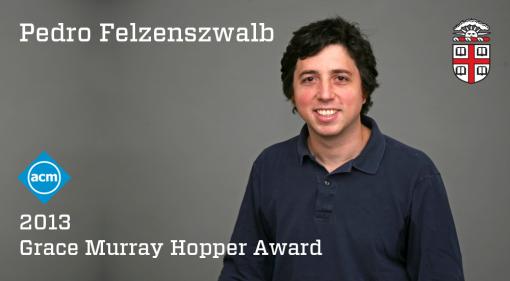 Pedro Felzenszwalb, Associate Professor of Engineering and Computer Science at Brown University, has just won the Association for Computing Machinery (ACM)'s Grace Murray Hopper Award for his contributions to object recognition in pictures and video. It's accompanied by a prize of $35,000.
Pedro Felzenszwalb, Associate Professor of Engineering and Computer Science at Brown University, has just won the Association for Computing Machinery (ACM)'s Grace Murray Hopper Award for his contributions to object recognition in pictures and video. It's accompanied by a prize of $35,000.
Pedro is the first Brown faculty recipient of the award, and he joins Don Knuth, Stephen Wozniak, and other notable previous winners. The Grace Murray Hopper Award is given yearly to an outstanding computer professional who makes a major technical or service contribution while age thirty-five or younger.
"Most of my research," Pedro explains, "is at the intersection of artificial intelligence, computer vision, and algorithms. It has a lot of applications, which I think is why it's gotten a lot of people in the community interested."
Pedro's research into object recognition started when he worked with Professor Daniel Huttenlocher (now Dean and Vice Provost of Cornell Tech) at Cornell University, then continued during his graduate studies at MIT and as a faculty member at the University of Chicago.
"Pedro's work has transformed the area of object recognition in computer vision," says Dean Huttenlocher, "to one where researchers are able to readily build on the work of others, rather than needing to build individual research systems from scratch. He has brought together the mathematically oriented and systems oriented parts of the field, to great benefit for us all. I feel honored to have had him as a student and longtime collaborator."
Brown Computer Science Department Chair Roberto Tamassia offers a similar sentiment: "I'm delighted that Pedro has received this major award, which recognizes his groundbreaking contributions to the important field of object recognition."
Pedro's recent technique uses a sliding window that moves around a given image, analyzing image data to verify the proper locations of local patterns. "It's a general approach," he says, "that can be used in many settings. I like that it is both theoretically interesting and also useful in practice. It's great to see these ideas have an impact in the community because they make sense and work well."
The community that Pedro speaks of clearly holds him in high regard. Professor of Applied Mathematics Stuart Geman, a colleague at Brown University, says, "Pedro's selection for the Grace Murray Hopper Award is no surprise. He has attacked the infamously hard computer vision problem with a singular mix of insight, mathematical rigor, and computational and statistical expertise. His brilliant work has changed the field."
"This recognition is very special," Pedro reiterates, "I am thankful to my colleagues and the support I received to do this work at Cornell, MIT, Chicago, and more recently here at Brown."
Pedro explains that he and his colleagues at Brown are looking forward to many more collaborations in the days ahead: "We're working in a very interesting area. The computer vision problem is still largely unsolved. There are many problems left to work on!"